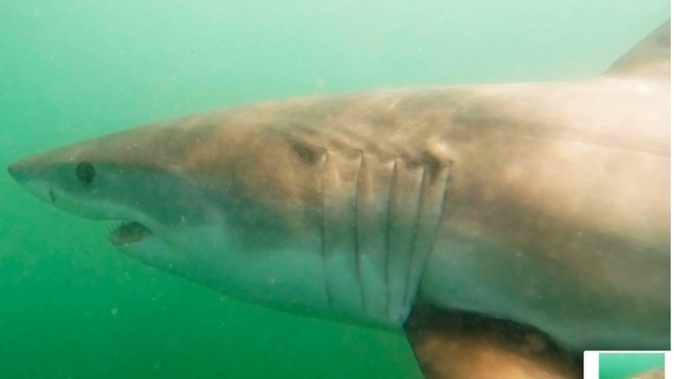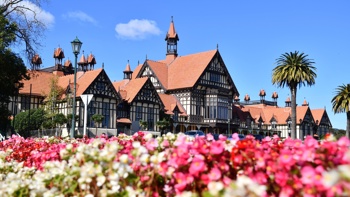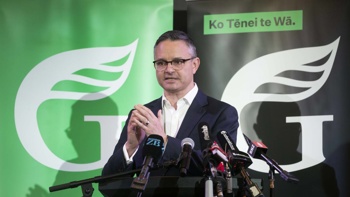
They’re an apex predator whose name can conjure fear in any avid beachgoer but a shark scientist who has been studying the movements of great whites in Bay of Plenty waters hopes his research will help people avoid adverse interactions and reduce ‘unnecessary hype and fear’, Emma Houpt reports.
A shark scientist who has spotted eight great whites in Bay of Plenty waters this month says his research will help create a “respectful coexistence” between the animals and those frequenting the ocean.
Tairua’s Dr Riley Elliott received a Department of Conservation permit in June to track and satellite tag 20 great white sharks, with the project allowing people to see where the animals are travelling through a live app.
So far he has seen eight great white sharks - in the Tauranga and Bowentown harbours - since starting his research at the start of December. The animals he saw ranged in size from 1.2m to about 3m long, he said.
Of the eight sightings, he has tagged two sharks in Bowentown.
The satellite tagging project was driven by funding and support from the public, with it costing $4000 for people to sponsor a shark.
It was run through the Sustainable Ocean Society - a non-profit established by Elliot and a group of his friends.
But despite the cost, there had been an “incredible” response to the call for financial support with 17 out of the 20 animals already sponsored.
/cloudfront-ap-southeast-2.images.arcpublishing.com/nzme/4DKIKUDSAFEZFGJZDHGV46TMRM.JPG)
- Water a greater risk to swimmers than sharks, surf lifesavers say
- Feeding frenzy: Up to 50 sharks filmed feasting off Cape Kidnappers
- Snake on a beach: Beachgoers stumble on venomous species
“The beautiful thing is it’s just all everyday Kiwis who are ocean lovers and just want to learn more.”
During the first two weeks out on the ocean, Elliot said he felt a “mixed bag of emotions” along with a sense of responsibility to succeed.
The first shark he spotted was a baby great white in the Tauranga Harbour about 1.2m in size.
“On one hand, I felt shocked this apex predator was in our holiday hotspot. But the other side was, this is a protected endangered baby great white so vulnerable to these boats, nets and carnage we’re about to throw into its peaceful life.”
Elliot, who features on the Discovery Channel’s Shark Week, said the research project was all about helping people to avoid adverse interactions with the animals rather than creating “unnecessary hype and fear”.
His goal was to educate people about the great white population while also reducing concern among swimmers, surfers, divers and boaties.
The research would also help him get a better idea of the animals’ habitat use and behaviour, he said.
“Having that knowledge creates a respectful coexistence with where an animal lives. We can learn where sharks are and mitigate risks around that.
“Through technology, we can reduce that risk, we can coexist and we can conserve what is an amazing endangered apex predator.
“Don’t be afraid of this project, this will empower you to feel less anxiety because no more will there be the unknown.”
He said there seemed to be public understanding the apex predators were “fascinating animals that needed protection” but also something to be aware of when on or in the ocean.
Elliot described tagging sharks as a “challenging endeavour” that required patience as the animals were shy and often avoided boats.
/cloudfront-ap-southeast-2.images.arcpublishing.com/nzme/W2F2XUY3YBARXO7V32WSE2MIP4.JPG)
He was calling on the people who spot the species to report sightings to him, saying it would make his job “so much easier”.
“What’s really been helpful is the public engagement - people reporting to me where they’re seeing. That’s how the citizen science keeps on empowering this project.
“If you see one, film it and report it. I would love to have like a million eyes on the water.”
Elliot said the process of satellite tagging included heading out in his commercial research vessel and “basically doing what the fishermen do”.
“I just start fishing - and when a great white turns up I will use a little piece of bait on a rope and bring it alongside the rope.”
Then using a “small broom handle pole” he put a dart holding a tag at the base of the shark’s dorsal fins where there were no nerves.
“That dart has a little piece of cable that holds the tag which is like a mini blimp.
“Every time the then shark comes above the surface and that blimp pops up above the water - it connects to a satellite and tells us instantaneously where that shark is.”
Asked what keeps him motivated to work on this project, Elliot said it was his “purpose” living in the area and having the skills required to do it.
“These animals don’t have anyone sticking up for them. I want to stick up for them because the more people who understand them and are aware of what they actually are - the less people that will hurt them. That’s my purpose.”
In November this year, a coroner recommended more research and monitoring of great white sharks after the death of a woman from a shark attack in the Bay of Plenty.
Kaelah Marlow, 19, died after being bitten by a great white shark at the southern Bowentown end of Waihi Beach on January 6, 2021.
The coroner’s report, which was released in November, said attacks by great white sharks were rare but almost always fatal.
- For more information about the app visit www.sustainableoceansociety.co.nz or report great white shark sightings to [email protected]
Take your Radio, Podcasts and Music with you









